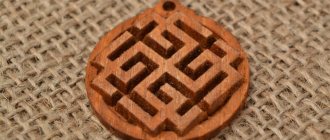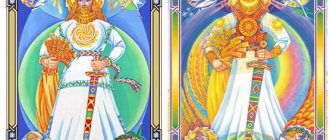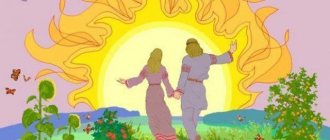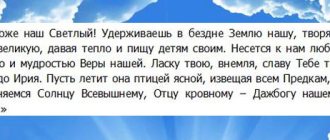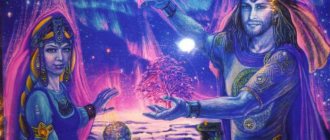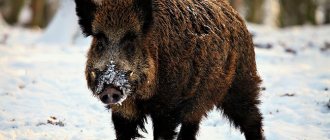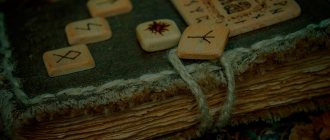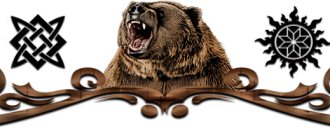When the earth was still young and people did not know the light, Svarog decided to set foot on the earth’s surface and learn about the existence of his mortal children. Since the world was in darkness, the Heavenly Father took with him his son, born from a spark of fire. And this child was wonderful, because he glowed and was warm like a coal in a fire. Svarog carried his son in his bosom and entered the dwellings of mortals that were without windows. In order to see the children of men, Svarog allowed his son to leave his hands and step in front of him in order to illuminate everything around with his light. And people saw the light and felt the warmth. Reaching out to Svarog, they only prayerfully asked: “God grant.” And Svarog saw that people were unhappy in the darkness and cold, and he decided that his son would henceforth bring his light and warmth to the human world. And this became a gift for people, and Svarog named his son Dazhdbog, in honor of the first prayer that fell from human lips. Since then, many years and winters have passed, and Dazhdbog regularly carries out his service every day, leaving his heavenly abode only at night, in order to rest from his affairs and worries. People still pray the same way, to their beloved Sun-God, and ask him for grace. And the cherished sound sounds: “God grant, grant.”
Dazhbog - birth legend
“The sky that bears the name of Svarog, the sky, the supreme blue steppe, the sky that gave birth to the Sun - Dazhbog!”
K. Balmont.
As they say, at the very beginning there was only one darkness (inertia, primordial chaos, “unmanifested”, “infinite”), in the bosom of which the Golden Egg arose, which brought to the Light the god Rod, the super-essential, primordial progenitor of the universe. Particles of the life-giving Light have not yet penetrated this part of the Universe and awakened life in it. This “dark” part of the universe, the so-called chaos, emptiness, but potentially containing life, manifests itself into existence as soon as a ray of Light from the highest consciousness illuminates it. Thus, by the will of the god Rod, everything that existed was awakened to Creation - this is how Svarog was born, who continued the Great Act of Creation of the universe, creating the entire world in the Forge of Heaven.
The original darkness was transformed by the movement that arose within it, revealing light and life. The will of Rod to love prompted the personification of Love itself to appear in the world - the goddess Lada - the mother-ancestor. The will of the Family to know gave birth to the Great and Wise Veles, who personifies Knowledge itself. The will to live brought into the world the goddess Zhiva, who herself is the life-giving force of the universe. This is how the first forces of the Universe were generated, thanks to which our entire world exists.
The light of the life-giving heavenly fire, generated by Svarog the Spirit-Father and Lada-Nature-Mother, with the first three sparks gave birth to Dazhdbog the Sun-faced, Perun - the heavenly warrior and Semargl - the fiery seven-flame Svarozhich. And with the fiery breath that arose from the blazing heat of the Svarozh Forge, Stribog, the grandfather of the winds and the patron of the air element, was revealed to the world.
“The sun is king, son of Svarog, who is Dazhbog.”
Ipatiev Chronicle2
The “Dove Book” says that “the red sun came from the face of God.” Our entire visible world, which we are given to see thanks to sunlight, is called “white” precisely because it is filled with the radiance bestowed by the Sun King. Our world is a Divine Creation, generated from the face of the central Luminary of the Universe.
So, Dazhbog is the first-born son of Svarog and Lada. He was born in the Heavenly Forge in Iria the Light, the first ardent spark that shone in the heavens, from which the whole white light was occupied. His brothers Svarozhich are the fire-haired Perun, born of the second spark and showing his strength and power in luminous lightning; The third spark lit the fire of Svarozhich on Earth - Ognebog-Semargl, giving light and warmth to people. All three Svarozhich are different manifestations of the fiery energy of the Universe: Dazhbog - the power of heavenly fire, Perun - the power of spatial fire, shining between heaven and Earth with lightning; god of the elemental power of fire Semargl. Dazhdbog represents the power of the primordial heavenly fire, which also gave birth to the fire of Perunov and Semarglov, but in mythology he is presented not as their father, but as an older brother.
But we will not delve into the intricacies of the divine hierarchy, for all such concepts introduce an element of division into that world, the existence of which is based on the highest laws of harmony and unity.
Vyshen-Dazhbog - the Sun King of our Universe
“Defend yourself, Russian land! You can’t let your enemies wrap you up so that they drive the cart, and you drive the cart where other people’s rulers want! Only the Light Gods, our intercessors, rule over us! Dazhbog, Perun, Horse, Yar, Kupala, Lada..."
“The Book of Veles”, part two “Trojan Ages”, chapter IV
So, Dazhbog continued the act of Creation begun by Svarog and Rod, filling the world with white light and endowing it with the power of life. For the created world to exist, it must be revived; this became possible thanks to the power of Dazhbog, the life-giver of the manifested world, who affirms the birth and development of the divine Creation everywhere.
As you know, the Dazhbogovs are called grandchildren in the chronicles of our ancestors. In particular, this sounds in “The Tale of Igor’s Campaign” in relation to the Russian army. In the “Book of Veles” Dazhbog is called our Grandfather and Father: “Only having our pure souls and bodies will we live with our forefathers, merging with the gods into a single Truth - so only we can be called Dazhbog’s grandchildren.”
(“The Book of Veles”, part three “Busovo time”, Busovo broadcasting),
“Brave Russians!
Your place is next to the God of War Perun and Dazhbog - your Father” (“The Book of Veles”, part three “Busovo Time”, chapter II).
So, the grandchildren of Dazhbozh - they are the essence of the sparks of the primordial Light, they are the souls of all living beings in the Explicit World. Dazhbog is the Source of Light, to which all souls gravitate. That is, our souls are CLEAR sparks of that divine pure Light that emanates from the Most High Svarga, therefore their radiance is initially pure and bright. They emanate from the Light of Dazhbogov, but their shine on Earth is temporary, but they will forever be in the Abodes of the Highest! For there is no death, just as the Almighty has neither beginning nor end, so life is endless and boundless Light. It is not without reason that in the Vedas the Sun King is called the “Eye of the World” - because this is the source of the creative power of the primordial Light.
It is important to distinguish that there is not only a visible Sun, but also a central or spiritual Sun. The Central Luminary is the core of the Universe, or the Sun King of the universe, the personification of which is our Dazhdbog, the Sun-Father, the heart of all vital forces in the world. Solar power is the root cause of life in Reveal. Dazhbog is the god of Light, the first-born of the Eternal Pure Infinite, whose energy is manifested through the Sun. He gives impetus to life to everything that exists under his invisible rays and the source of “sparks of the spirit.” The visible Sun, the center of our Solar System, is a mirror reflecting the radiance of the Supreme Sun. It receives light from the King Sun and radiates it to the Earth. This is a reflection of the Origin, which in itself is inaccessible to vision.
In the “Book of Veles” they call him the Most High-Dazhbog, and it is said that the Most High is Dazhbog, who is revealed to us as the Sun King in our Universe. The light of the Dazhbogs permeates the entire universe, it is also the source of life, the Spirit. There is more than one Sun in the world, but each one is the face of Dazhbog.
Meanings of the deity sign among the Slavs
Silver Slavic amulets with Dazhdbog were used by people whose professions were directly related to the fertility of the soil and the mood of nature. Dazhdbog is a protector of warriors on long journeys and a talisman for the homes to which they returned .
We recommend: Universal symbol - Torch: what is the meaning and how to activate the amulet?
The power of Dazhdbog charges the wearer with positive energy and helps to successfully complete the work started. The amulet not only protects the owner, but also guides him and shows him the right path. The wearer feels a surge of courage and fearlessness.
Dazhbog - patron god of white light
“Dazhbog sails on his boat in the blue Svarga, and that boat shines... This is the Spirit of all life and the refuge of all things on Earth.”
“Veles’s Book”, Krynitsa.
Dazhbog is the personification of Light, without which the material world would not exist. This world is called “Reality” - obvious, perceived, manifested being, it is also white light. In contrast, Nav is an unmanifested or potential being. Reality is the world perceived through the senses. Especially in Yavi we gain invaluable experience for the development of consciousness.
Our whole world is light, which is why they call it “White Light”!
On the physical plane, thanks to vision, we have access to the perception of energies, in particular through color. If we consider light precisely as a material substance, then at the level of perception of physical existence we can observe this in the surrounding world of forms. But we don’t see everything that fills the space around us... Let’s think about why, and this will clarify for us the nature of the light given by Dazhbog.
What is color? This is light that is reflected from the surface of any material object and gives a corresponding perception of color that is accessible to our vision. Natural color is essentially a reaction of “attraction” to certain rays of light. Just as matter, which is a manifestation of radiant energy emanating from the Central Sun, radiates itself in space and, depending on what kind of vibration the rays carry, manifests itself in different ways, so also invisible to the eye, unmanifested energy is felt by us differently, depending on on how close or far it is from our plane of existence.
So, color is a vibration3 of energy visible to the eye that resonates with some part of the entire spectrum of colors, which contains white light (sunlight includes the entire spectrum of colors). Basically, a person is able to perceive only a small part4 of the entire spectrum.
So, using the example of a rainbow
, which is the result of the “splitting5” of white sunlight into the primary colors of the spectrum, we see that light is energy that combines all others, without separation. But when it hits the surface of a material object that emits a certain vibration, it gives us the opportunity to see what kind of energy it is, in particular, in the form of color reflected from it. Light illuminates the world, giving us the opportunity to see it, while in the darkness everything is “colored” in only gray and black tones.
So, for example, a mirror reflects all the sun's rays, so it is transparent, and white color is the result of reflecting most of the sunlight while partially absorbing it, while black mainly absorbs light and emits nothing. For example, let’s also turn to the world of minerals6 with natural colors. Thus, blue sapphire, when exposed to sunlight, absorbs all the colors of the spectrum except blue, which it emits, which is why it is perceived by our vision as blue. And red ruby almost does not absorb the red part of the light spectrum, since it mainly emits it. This is vibration, in other words, the pulsation of life,
emitted by living stone, which we are able to see in the world of living nature thanks to the perception of color.
Of course, any artificial (and therefore lifeless) paint does not give an idea of the energy of the object painted with it. It does not carry any information at all and, rather, only distorts perception, creating an illusion. And the natural color given by nature carries the vibrations of life.
This is the nature of Dazhdbozhy’s light, which manifests life and allows us to perceive the physical plane of existence, which is a necessary and important step on the Path of evolutionary ascent.
Slavic myth about the crucifixion of Dazhdbog
There are references to the fact that Jesus is the incarnation of Dazhdbog
There are references to the fact that Jesus is the incarnation of Dazhdbog. The ancient Slavic-Aryan epic indicates that Dazhdbog was not conceived in a carnal way, like Jesus. He also resurrected, after which he ascended to heaven along the legendary Alatyr-stone.
The Slavic myth about the crucifixion of Dazhdbog says that the goddess Morena crucified him because the sun god rejected her love. The crucifixion of Dazhdbog took place on a high mountain. This is how A. Asov reproduced this event in the book “Russian Vedas Kolyada”:
And she hammered an iron nail into her leg, and drove another into the other. She drove a nail into Dazhdbog's white hands. And she dropped the last nail.
It is believed that information about the nail that Morena dropped is in the Gospel. The fifth nail of the Slavic goddess of death is the tip of the spear of a Roman centurion. The centurion understood the phrase that Jesus said in his native language after he was crucified:
Or or! Lama savafkhani!
The Jews and Romans did not understand this phrase. According to the records of St. Dmitry of Rostov, the Roman centurion was a Cappadocian. Herodotus wrote that Cappadocia belonged to the Aryan or Slavic lands. The Cappadocian Scythian understood the phrase spoken in Proto-Sanskrit, or the language of the Scythians. The phrase pointed to the self-sacrifice of Jesus Christ for the sake of humanity.
But why did Morena lose the fifth nail? After all, Jesus-Dazhdbog was killed by him. After the death of Jesus, the spear became the Spear of Destiny - an artifact that is considered lost. It ceased to be an instrument of death, giving healing to the suffering. Thus, the goddess of death lost her weapon.
Dazhdbog - god of sunlight
“The light in your soul will flare brighter and purer. And from its sparks the heat-fire will flare up... If the Sun rises, With the unity of grief, Your darkness will disappear and the dawn will shine brightly.”
A. Navoi “Language of Birds”.
The gods of the visible Sun in the Russian Vedic pantheon of gods are represented by four faces: the winter Sun Kolyada, the spring Sun - Yarilo, the summer Sun - Kupala, the autumn Sun - Khors. All of them are hypostases and manifestations on the earthly plane of existence of the highest Dazhbog Light.
Young spring Yarilo is the personification of youth and fullness of strength, awakening to life. Summer Kupala is the personification of wise maturity. The autumn elder Khors is a symbol of the fading energy of life, the completion of the path. The winter reborn Sun - the “baby” Kolyada - personifies the turning of the Wheel of Life from death to new birth.
However, there is also a version that Dazhbog is the god of the summer Sun. There is also a legend according to which, during the winter season, Dazhdbog hides his bright face in the monastery of the goddess of winter and death, Morena. While he sleeps, enchanted by her chilling spells, his golden-maned horse carries the Shield of the Dazhbogs across the sky, but in due time he awakens and ascends to his chariot in order to once again complete his Path in heavenly Svarga. This legend can be interpreted as the movement of the summer Sun across the sky, moderating its ardor, heat and light in winter and being reborn again with renewed vigor in summer. But, as mentioned above, the summer face of the Sun is just one of the incarnations of the Bright Dazhbog.
As the god of sunlight reflected into our world by the central star of our Solar System, Dazhdbog also appears in the form of daylight, thanks to which we perceive the entire material world through vision. There are many etymological parallels in different languages between words denoting daylight, day, sunrise, solar rays, radiance of light, the Sun itself, and words associated with the ability to contemplate this light and the world illuminated by the Sun: eyes, eyes, vision.
So, for example, “pupil (zrak)” among the Serbs means “ray of sunshine”; “vision” or “see” are clearly related in root to the words “dawn”, “glow”, “dawn”; the word “sharp” also means “clear”; eyes in the mythologies of many peoples were associated with stars shining from heaven: in Sanskrit bhās (भास्) - 'to be obvious, obvious', it also means 'to sparkle, shine', and also has the meaning 'brilliance, light', the word bha (भ ) - 'star, luminary, Sun'; "to marvel" is similar to the Sanskrit root div (दिव्) meaning 'to shine, sky, radiance, radiation'.
These etymological parallels are reflected in the naming system for the months. So, A.S. Famintsin7, describing the system of Slavic mythology, points out that among the Croats and Czechs the month of December is “Prosinets”, that is, the month when the rebirth of the Sun occurs, or its “shining”.
Symbol and amulet of Dazhdbog.
Since Dazhdbog is a solar god, that is, a solar god, the disk is considered his symbol. Dazhdbog belongs to the great Slavic solar triad of gods: Khors, Yarilo and he, but since Khors is the god of the winter sun, Yarilo of the spring, and Dazhdbog himself is the god of the summer, the disk, as the embodiment of the full and mature sun, is exclusively his sign. The most common sign of Dazhdbog is also the solar square, which has many similarities and similarities with the Svarog square and the Lada star. This square contains the sacred meaning of the very power and grace of the deity: his light and love extends to all four corners of the world. Also among the symbols of Dazhdbog is the ruby, which is recognized as the personal stone of the deity. The Dazhdbog amulet is not only a great honor, but also reliable protection. For young people, this amulet is a path to enlightening the mind and acquiring the strength and understanding that are needed to overcome all life’s difficulties and obstacles. The Dazhdbog amulet will allow you to find the right solution from a difficult situation and attract a worthy life partner. For representatives of the older generation, a talisman is a way to gain peace of mind, health and find a common language with the younger generation. In general, the Dazhdbog amulet is designed to make people happy, to attract love to them, but it also allows the wearer to understand that his happiness is within himself and depends on his thoughts and actions. The Dazhdbog amulet was made of wood or soft metals. It was also embroidered on napkins and carefully carried in pockets located on the chest, closer to the heart.
Dazhdbog - meaning of the name
“At Lukomorye every day we turn our gaze to the Gods who are Light. We call this Light Perun, Dazhbog, Khors, Yar and other names. And we sing glory to the Gods.”
“The Book of Veles”, part two “Trojan Ages”, chapter IV.
The name Dazhbog (also called Dazhdbog, Dazhbog, Dazhba, Dashuba) means “giver of light” or “giver of life.” And it is not at all connected with rain, just as his name can be mistakenly interpreted in one of the variations - “Dazhdbog”. Let's talk about this in more detail, analyzing the etymology and morphology of the name of our Light God.
The name of the god of sunlight comes from the word “giver” or “endower,” that is, the god who gives us life, light, warmth, protection, patronage. By the way, in Sanskrit the word “to give” is also based on the root da (दा). We see that the etymology of the name Dazhdbog in this case comes down to the meaning of “giver”, “bestower”, that is, God the Benefactor.
Also, the name Dazhbog can be interpreted as “Light God or “God of Light”.
Dazhbog - “Dazhiy god”, which means Day God or God of Fire. According to A.N. Afanasyev8, the name Dazhbog is related in root basis to the Sanskrit dah (दह्) ('burn'), Old German dag ('day') and the Lithuanian verb degu ('burning'). “Dazh” is an adjective from “dag” (Gothic dags, German tag, Sanskrit ahan (अहन्) instead of dahan) - meaning 'day', 'light'.
As mentioned above, Dazhbog is also called Svarozhich, that is, the son of Svarog. We find the name “Svarozhich”,
referring to the god of the Sun, in the apocrypha9: “Ini believe in Svarozhitsa and in Artemis” - which suggests a direct reference to the Sun and Moon, with which the goddess Artemis10 is personified in the ideas of the ancient Greeks.
Also, according to A.N. Afanasyev, with the ancient name of the Sun Dazhbog, the identity of the name of the morning dawn can be traced among the Slovins, which is called “dzhnitsa”, which is also related to the name of the star Dennitsa11. That is, the Sun at sunrise glows in the morning sky like a lit lamp. And here we see a metaphor, because Dazhbog is the son of Svarog, born in the heavenly Svarga.
Features of tattoos with symbols of God
Tattoos always carry a sacred meaning . These signs can be both helpers on the path of life and enemies. Slavic runes quite often become the basis for tattoos.
However, not every rune and symbol is suitable for constant wear. Some signs can negatively affect a person’s character, his destiny, and the positive meaning of the symbol will become completely opposite.
An incorrectly filled rune can ruin the life of the wearer . Moreover, there is simply no point in covering up such tattoos, so you will have to completely remove it with a laser.
However, with the Dazhdbog rune things are different. It can easily be used as a design for a tattoo, but it is important to carefully consider this decision and learn to accept solar energy.
The Dazhdbog rune is often tattooed to achieve material success and prosperity in all areas of life. In the old days, such a tattoo carried the meaning of fertility and a rich harvest.
With a respectful attitude towards the culture of the Slavs and Dazhdbog, as well as with a full understanding of why you need his runic power, you can safely apply a tattoo with this sign on your body and not be afraid of negative consequences. If Dazhdbog is your patron, then such a tattoo will only play into your hands.
The sunny Slavic amulet Dazhdbog has illuminated the path of life for many people for a long time. It helps you find the strength to overcome obstacles, find peace of mind and fulfill your most cherished desires.
Vyshny Dazhdbog - Slavic god
“And Vladimir began to reign in Kyiv alone, and placed idols on the hill behind the tower courtyard: a wooden Perun with a silver head and a golden mustache, and Khors, Dazhbog, and Stribog, and Simargl, and Mokosh.”
Laurentian Chronicle.
In Serbian and Bulgarian Christian legends the name “Dabog” is found, and it quite obviously carries the meaning of the bestowing, good-giving, light of God, however, this god is presented by Christians as the antipode of the heavenly god, and it is no wonder that the Light God of solar light, whom our ancestors revered before the adoption of Christianity in Rus', they attributed the characteristic features of a deity opposing the light, thereby deliberately distorting the original essence.
The Western Slavs have preserved mentions of Dazhdbog in the form of geographical names, in particular a tract called “Dats-Bogi”. And near the Baltic Sea, as was discovered by the researcher of Slavic mythology A.S. Famintsyn, there is the Dazhi region, as well as the Dazhi Lake and the Dazhi Forest, the names of which were probably given to the Bodrichi tribes that once lived here. Similar names of places are found in German lands, inhabited in ancient times by the Baltic Slavs.
Also, as mentioned above, among the northern Slavs the veneration of Dazhbog was mentioned in the Nestorov Chronicle.
Who is Dazhdbog
In the faith of the Eastern Slavs, Dazhdbog is the god of sunlight, warmth, fertility and the giver of good to people.
An excerpt from the Ipatiev Chronicle about Dazhdbog, the son of Svarog.
He was depicted as a middle-aged man of strong build with heavenly eyes and blond hair. On a chariot drawn by horses with golden manes or lions. Ducks and swans always flew in front of the chariot, as a symbol of the morning dawn and evening sunset.
People believed that the bright light was the reflection of the sun reflected from the armor and shield of the summer god. The son of Svarog possessed magical powers which he used only for good purposes. Dazhdbog was also a skilled warrior, but more often he used a shield to repel evil.
Prayer to Dazhdbog - the Ardent Red Sun
“For we come from Dazhbog, and we became glorious, glorifying our Gods, who are our forefathers, and never asked or begged them for our good.”
“The Book of Veles”, part one “Rodovichi”, chapter III.
Our ancestors never prayed or asked the gods for worldly and transitory blessings, but glorified their eternal names, so that they would sound in the world of Reveal and rise to the heavens of the world of Rule. For this, the bright gods bestowed strength and wisdom and led him along the Right Path. In the same way, we should not forget our gods, but glorify and THANK them.
Any word we pronounce carries a certain vibration with which it fills the space. Therefore, it is so important to monitor what we say and avoid rude and aggressive words. We need to understand that these energies fill our world and watch the words spoken. The person to whom we are rude or scolding may not accept the negative message sent to him, but this will remain with us in any case.
If we fill the world around us with only light energies, then we will receive only good in return. By pronouncing words filled with light energy, we ennoble the world. This is the power of prayers, praises, and ritual prayers to the gods. So, there are certain sacred syllables, which are combinations of sounds that connect us with certain forces. One of these mystical syllables is “RA”, which carries the energy of solar light, given to the world by Dazhbog. “Ra” is the name of the original Light of the one Supreme God, whose luminous power pours out from the Svarozh monastery to Mother Earth, giving life-giving and JOY to all that exists.
Praises to the gods, supported by mental images, have particular power. That is, it is one thing when we simply look at the Sun, and quite another when we turn to it with our minds - when we reflect on its nature.
Let us give some variations of praises and prayers to our Dazhbog.
“Golden-rayed, bright-eyed, bright god Dazhbog, Glory to you for all time in all worlds!” “Blessings to the giver! In the heavenly shining Svarga! To our grandfather, the many-wise God! Glory to Dazhbog!” “Ardent Red Sun! Shine in heavenly Svarga and pour out Light with brightly radiant fire! White light shine! Warm Mother Earth with fiery rays! Glory to Dazhbozh, Light-faced wise god!” “Glory to you, face of the White Light! Dazhbog - Triple-Bright Sun! Keep your Path across the blue sky And bestow the blessed light of joy on your Grandchildren!”
There are also such ritual rumors, which are better to be said in the morning, bestowing benefits on a person for the whole day to come:
“Rise, dawn, O Trisvetny Dazhdbog! Arise, dawn, O One who dwells in the Heart! Rise, dawn, Sun-faced! Do good to the world!
In Krynitsa, the Books of Veles glorify Dazhbog with these words:
“We praise Dazhbog! May He be our intercessor and patron from Kolyada to Kolyada. And He will protect the fruits in the fields, multiply the grains in the granaries, and prevent the honey from hardening. He is the god of Light. We praise Svarozhich!”
Let us also quote the text of the Hymn to the Sun12, glorifying the splendor of the divine radiance:
“To the Sun, compassionate, great in Spirit, having seven swift zealous horses, possessing great glory, awakening the beauty of lotuses, splitting the veil of darkness, respect to you! Respect to the Sun, who creates virtue through the abundance of light of radiant fire, bringing good to the whole world! To the Sun, the cause of all three worlds, the soul of created beings, the ruler of heaven, the highest house from where the eye rose, respect! To the Sun, which is supported by knowledge, which is the innermost soul, the foundation of the world, desiring good, self-existent, the eye of all worlds, the highest among the gods, limitless in glory, be reverent! To the sun, consisting of a thousand widely spreading rays of light, shining on the world, driving away darkness and gloom, reverence! Oh, Sun, you shine with the reflection of a single source of infinite Light and call the worlds to life. Mounted on your splendid chariot, which sways gracefully and delights beyond measure, with ever-tiring steeds, O beloved god, you go through the wide world for our good. Glory to you! O Sun, you, creator and purifier of the three worlds, are kind to people who revere your greatness! You are like a lamp of all worlds - you bestow pure and blessed light on everything that exists and awaken life in all its diversity. Glory to you!
Who was Dazhdbog for our ancestors?
In his studies of Slavic beliefs, I. P. Medvedev described Dazhdbog as follows:
Dazhdbog is the god of the pagan Slavs. Patron of fertility and the Sun, source of life-giving force. Dazhdbog was considered the forefather of the Slavic peoples.
In book reading, this is the correct definition. Ethnographer S.I. Murtuzaliev expanded the dry definition of the role of Dazhdbog in the world order of the Slavs. According to his analysis of the cult of Dazhdbog, the god of the Slavs acts as “the giver of the blessings of all.” At the same time, he clarifies that it was typical for the Slavic psychotype not to separate the spiritual and the material.
Our ancestors praised their God, but in their speeches there were no formulations like “give me earthly blessings.” It was believed that the gods had already endowed the world with everything it needed. All that remained was to learn how to receive these benefits to support life.
At the same time, it was believed that the gift includes more than just a material component. Harvesting meant:
- receive joy from a rich harvest;
- a calm mood, since the autumn-winter period will pass without hunger;
- health and satiety;
- community prosperity;
- increasing the number of descendants;
- the joy of departed ancestors for their children in this world.
The image of the bright Dazhdbog combined more than just the functions of the patron of a specific phenomenon.
Dazhdbog Day. Holidays honoring the power of Dazhbogov
O Sun, shining Light! You are Grace coming from heaven!
Let's consider what holidays exist that honor Dazhdbog the Light.
All four holy days of the year can be classified as holidays that honor the power of Dazhbogov - the power of solar light, when it is glorified as Kolyada, Yarila, Kupala and Khorsa. On the day of the autumn equinox, the power of Dazhdbog is glorified, turning the sun's bell towards winter. This day is associated with the wedding day of Dazhbog and Morena. Winter Solstice, when the newborn Dazhbog in the form of baby Kolyada shows his face to the world, turning the sun's beacon towards summer. The spring equinox, when the light given by Dazhbog shines with the radiant face of young Yarila. The summer solstice, bringing the Dazhbogs Light and warmth, manifested in the face of the summer Sun god Kupala. According to popular beliefs, on Komoeditsa 13 (Maslenitsa) Dazhbog begins his journey across the Earth on his golden-maned horse, and from the clatter of hooves she awakens from her winter sleep.
Rituals that honor the power of the sun: lighting a wheel as a symbol of the Sun, shining with a fiery ardent light, which is rolled from a mountain into a river, or rolling a wheel out of a lit fire - are associated with the symbolic rotation or accomplishment of our Luminary's eternal Path through the heavens. It is believed that the fires lit during solar turns served as an emblem of the heavenly fire of Dazhbog.
The day of Dazhdbog is also considered “Spozhnik” in the month of August as the day of the end of the harvest. Dazhbog, together with Mother Raw Earth, is thanked for the gift of food and the rich harvest with which they bless people.
May 6 is also considered Dazhdbog Day, when the warmth of the spring Sun, which revives Nature, is revered. This day in mythology is associated with the wedding day of Dazhbog and Zhiva. They say: “Dazhbog brought spring to the threshold.” In addition, December 9 is also considered the day of Dazhbog and Madder.
God Dazhdbog in the Slavic pantheon
According to the “Tale of Bygone Years,” the idol of the sun god was located along with the idols of Perun, Khors, and Svarog on a hill in the pantheon of gods and occupied a special place in the hearts of the pagans.
The goddess of summer, the wife of Dazhdbog, is alive. rice. Two Vasilyeva.
It is believed that all Slavic peoples are the grandchildren of Dazhdbog. The laws of the universe given to people by God, who give blessings, are still in effect to this day.
The law of love says: “if there is no love, then everything will fall apart, nothing will work out, nothing will be built, everything will collapse.”
God Dazhdbog - attributes. Image
In mythological legends, Dazhdbog is described as follows. He is driven by a golden chariot along a heavenly path, paved by the light of the Sun. His shield is the red Sun - that shield was forged in the Forge of Svarogova. Dazhbog is depicted as a bright horseman, riding a golden-maned horse across the heavenly expanses, above the clouds. His shield illuminates the three worlds with ardent light, and with eight rays, like fiery arrows, it reflects the face of the Great Sun.
It is believed that the trees of Dazhbog, like Svarog, are beech and maple. The sacred animals protected by the sun god are: wolf, raven and horse. As a rule, the emblem of the Sun God was a white horse as a symbol of light.
Sun God Dazhdbog - analogies in the mythologies of different nations
In the mythological tales of different peoples, the solar gods are represented, as a rule, as the supreme deities of pantheons of gods, ancestors, givers of life and light.
In ancient Egyptian mythology, the supreme god of the Sun is Ra, the son of the primordial ocean Nun and the sky Naunet. He is also the essence of the god Atum - the demiurge, who “is Ra in his first sunrise” (“Book of the Dead”, chapter 17). God of first creation and personification of the Sun. In ancient Egyptian mythology, the Sun was also called the “Eye of Osiris” - the first-born Light.
In Sumerian-Akkadian mythology, the sun god Shamash (“lord of the day”) is the giver of light, fertility and prosperity.
In ancient Greek mythology, the god of the sun is Helios. In the Ipatiev Chronicle we find an insert from the Greek chronicle of Malala, where the god Helios is translated as Dazhbog: “and after (Svarog) his son reigned, called the Sun, his name is Dazhbog... The Sun is the king, the son of Svarog, who is Dazhbog, for the husband is strong "
And also the ancient Greek Apollo14 “radiant” - the god of light and the personification of the Sun, the son of Zeus-Sky - the god in charge of the whole world, and the goddess Leto. Similar to Dazhbog, who is also the son of Heaven (Svarog).
In ancient Roman mythology, Jupiter himself was revered as the god of sunlight - the powerful ruler of Heaven and the supreme ruler of the gods. Before Jupiter, the god Janus was the personification of sunlight and the deity of Heaven; he opened the heavenly gates and released the solar chariot into the sky.
In ancient Iranian mythology, Mithras is the god of sunlight, “the lord of divine light,” as the sacred “Avesta” says. Vedic Surya (originally Vivasvat), the son of the boundless space of Aditi, is also a prototype of the central Sun of our Universe. He is identified with Vishnu (Surya-Narayana). In the Bhagavad-Gita (chapter 15, text 12), Vishnu, appearing in the form of his avatar Krishna, says: “The radiance of the Sun, which dispels the darkness reigning in this world, originates from me, just as the light of the Moon emanates from me and fire."
Being a representative of the Vedic Trimurti15, which included such gods as Surya, Indra (or Vayu and Agni), he is identified with Dazhbog - the eldest Svarozhich in Triglav of the Russian Vedic pantheon of gods (Dazhbog, Perun (or Stribog) and Ognebog Semargl).
An ancient translator of the chronicle of Malala draws analogies between the name of the god of heavenly fire Hephaestus (“Ηφαισος”) with Svarog, and the god of the Sun Helios (“Ηλιος”) with Dazhbog.
A.S. Famintsyn correlates Dazhbog with the god of the day in German mythology under the name Tag, or Dag, Dagr, who follows the firmament on a golden-maned horse. Obviously, the god Tag was the god of the Sun.
Also, the sun gods of the Aztecs were Tonatiuh (the name means “Sun”), among the Mayans - Kinich-Ahau (“Sun-faced Lord”), among the Incas - Inti, the progenitor of life.
Interesting Facts
- The meaning of the name of the Slavic god is the giver of prosperity. The deity's name probably comes from the phrase "God willing" (i.e., God willing). Therefore, despite the similar sound, Dazhdbog is not the god of rain at all.
- The god's amulet is a disk representing the sun. The symbol of Dazhdbog is considered no less powerful - a solar square, outwardly similar to a swastika.
- There is a rune whose name is similar to the name of the solar god. In fortune telling, the rune symbolizes abundance and prosperity.
- The ancient Slavs believed that the Dazhdbog conspiracy would help drive out evil from life and fulfill any desire.
Dazhdbog: symbol. Solar square of Dazhdbog. Idol of Dazhdbog
The Solar Bracelet of Dazhbog, also known as the Shield of Dazhbog, is a symbol of the Sun, depicted in the form of a rotating eight-rayed cross with curved ends in a circle. The eight-rayed bracelet is a symbol of the Sun-faced god Dazhbog.
The rotator is an image of the movement of the Sun in Kolo16 (a circle), and also represents an image of the eternal cyclical rotation of the universe, in which the central axis represents the original energy of the ancestor god, who awakened all things to Manifest existence.
This rotation does not occur in a circle. In our world, everything is created according to the law of harmony, and the energies of evolutionary ascent follow in a spiral. The movement of energy in a spiral is inherent in the formation of all forms of the visible material world. This is the plan of God the Creator, who launched the impulse for the dynamics of the development of primary matter. This “pattern,” like the principle of similarity reflected in the golden Fibonacci spiral17, which is observed everywhere in nature, lies at the basis of the development of the Solar System. By the way, our spiral galaxy, the Milky Way, is in the form of a four-rayed whirlpool. It is important to understand that rotation does not imply a constant return to the starting point, but with each new turn of the spiral of evolution, ascension to new levels of existence on the Path of development of Consciousness.
In modern amulet art, the most famous is the solar square of Dazhdbog, which is an equilateral quadrangle consisting of four rhombuses (the upper and lower rhombuses are closed, the left and right are open). A small idol of Dazhbog carved from wood can also serve as a talisman. It can be installed at home, on the altar, facing east - towards the rising Sun. As a rule, it depicts either the Dazhdbog rune, or the rune of the heritage of the Odil family, or the solar square of Dazhdbog (summer or winter), or the image of the sun; and in his hands he holds a sheaf of ears of grain as a benefactor and breadwinner.
The runes that personify Dazhbog’s power and grace are the following: the rune Sovilo (Sol) is a life-affirming symbol of the Sun, a sign of movement along the Path of self-knowledge in the name of spiritual improvement; the rune of fertility and reproduction Yngvi, which is a symbol of the creative energy hidden in every living creature and illuminating its Path; The Dagaz rune is a symbol of the day, transformation, change for the better, the rising and setting of the Sun, which gives strength and energy to life.
The amulets and signs of Dazhbog grant protection, gaining mental balance and health, happiness and well-being in life, and most importantly, they help us come to the realization that the source of happiness is within ourselves, and not outside, and adversity and vanity will not leave us until we will not find inner harmony.
Holidays dedicated to Tarkh (Dazhdbog)
In their appeals to Dazhdbog, the Slavs asked for fertility of the lands, health for the family, and for the cattle to return home after the summer.
They brought gifts of apples and honey. In the modern calendar, these days are marked as apple and honey days (August 14 and 19).
The spring celebration falls on May 5-11, the time when the influence of the Slavic goddess of summer - Zhiva - began.
It is believed that the Christian Jesus Christ is the incarnation of Dazhdbog, the giver of all blessings and a symbol of love for people
.
Dazhbog's main parting words
It is important for each of us, the “grandchildren of Dazhbozhy,” to learn to transform, or “refine,” heavy, dark energies into light ones, directing inner light to them and purifying them with higher vibrations of our light souls. In nature, everything exists according to the law of harmony and balance, therefore the light that we emit fills the world and around us. It is impossible to bring light without shining yourself and without radiating it with your heart. There is light in each of us. Our hearts are the abode of pure eternal Light. But sometimes its radiance fades, darkened by the darkness of ignorance and the burden of pride.
Open your hearts to the light of Goodness and Love that fills our entire world! Let pure bright joy fill you!
PS Remember that, no matter which of the native gods of light we glorify, we always glorify the All-Existing God of the Primordial Creator, who manifests himself in the faces of many, revealed by the gods as his hypostases. Therefore, by honoring Dazhbog, we glorify the Generosity and Lightness of the Most High Progenitor of the Family, the light of wisdom that disperses the darkness of ignorance and the ardent heat that incinerates the darkness of falsehood, and the Light that fills every living creature in our world with life.
Ohm
Who are suitable for amulets with the sign of a deity?
The Dazhdbog sign can be worn by people of any age, gender and status . The solar amulet maintains harmony regardless of the characteristics of its wearer. It benefits everyone who wants to change their life in a positive way. However, remember that the amulet affects young and adult people differently.
Dazhdbog gives young girls and boys self-confidence, wisdom and a surge of strength. In older age, the amulet protects the harmony of life and maintains a fragile balance.
The Dazhdbog amulet is ideal for those who are trying to realize themselves in life with the help of their knowledge and skills. Schoolchildren and students, as well as novice magicians, are precisely those categories of people for whom Dazhdbog’s magic is especially useful.
We recommend: Symbol of light Perunitsa: description and meaning of the amulet. How to use the amulet correctly?
Dazhdbog helps those who doubt their abilities and the correctness of their decisions to find themselves and their path, not to give up, being three steps away from their cherished goal.
